2024-04-29
Written by: Anne Fearless
Views: 693
This is one of the articles that was submitted to the Secrets of Tibia 3 contest and won the 2nd place. It was written by Anne Fearless
Since ancient times, humanity has given very particular meanings and symbolism to animals: sometimes positive, such as the dog that represents loyalty or the owl, which is a symbol of intelligence; and sometimes negative like the snake that we associate with evil and poison or the pig that we associate with dirt; without any of this having to do with what these animals are like in real life. Sometimes the symbolism of an animal even changes depending on its sex (especially in languages that have grammatical gender), for example a male fox is cunning, but a female fox or a vixen is a prostitute. And of course all these relationships will vary from culture to culture, or from time to time.
Among all animals, one of the most representative of the collective imagination, throughout history, has been the lion. The iconography of the lion refers us to values of power, strength, protection and royal dignity. It is not for nothing that this animal is considered the king of animals or the king of the jungle (even though it does not live in it), and it stands out in art and thought among all animals and among all felines. However, it also presents an ambivalence where, to a lesser extent, some negative characteristics are attributed to it, such as fierceness that harms humans (for example, in representations of lions that ate gladiators). However, within this duality, the positive connotations always win in the lion. And this same thing happens in Tibia: in this article I will analyze how the symbolism of the lion in real life nourishes that of the lion in the game, and how also this ambivalence of positive and negative values (with the former triumphing) is crucial in the development of the modern lore (which can be understood since update 2014) of Tibia.
In our real world, the positive aspects that characterize the lion are, in fact, so good to the point of equating being the king of the animals with being the king of the world: making it a representation of both monarchs and Jesus Christ himself(1) (not for nothing did CS Lewis choose it to play the mythical Aslan). In this way, not only in religious contexts but also in political and secular contexts, the lion has enjoyed a fairly good association with power:
The lion is a type of feline and it is one of most depicted animals in art throughout history. It is an icon present in all cultures, carrying values of power, strength, courage, dignity or royalty, and it was adopted either in secular as well as in religious contexts. [...] / The lion is one of the guardian animals par excellence. The lion shape is also a constant resource in political symbolism and the emblems of war. It supplements the image of power and its presence extends to areas as diverse as astrology, embodying the constellation Leo. As in the West, the lion is a common motif in the aulic iconography of the Islamic world, and symbolizes courage, strength and royal magnanimity.(2)
The lion is also a very protective creature, which is why lion statues often guard the doors of temples or sacred precincts:
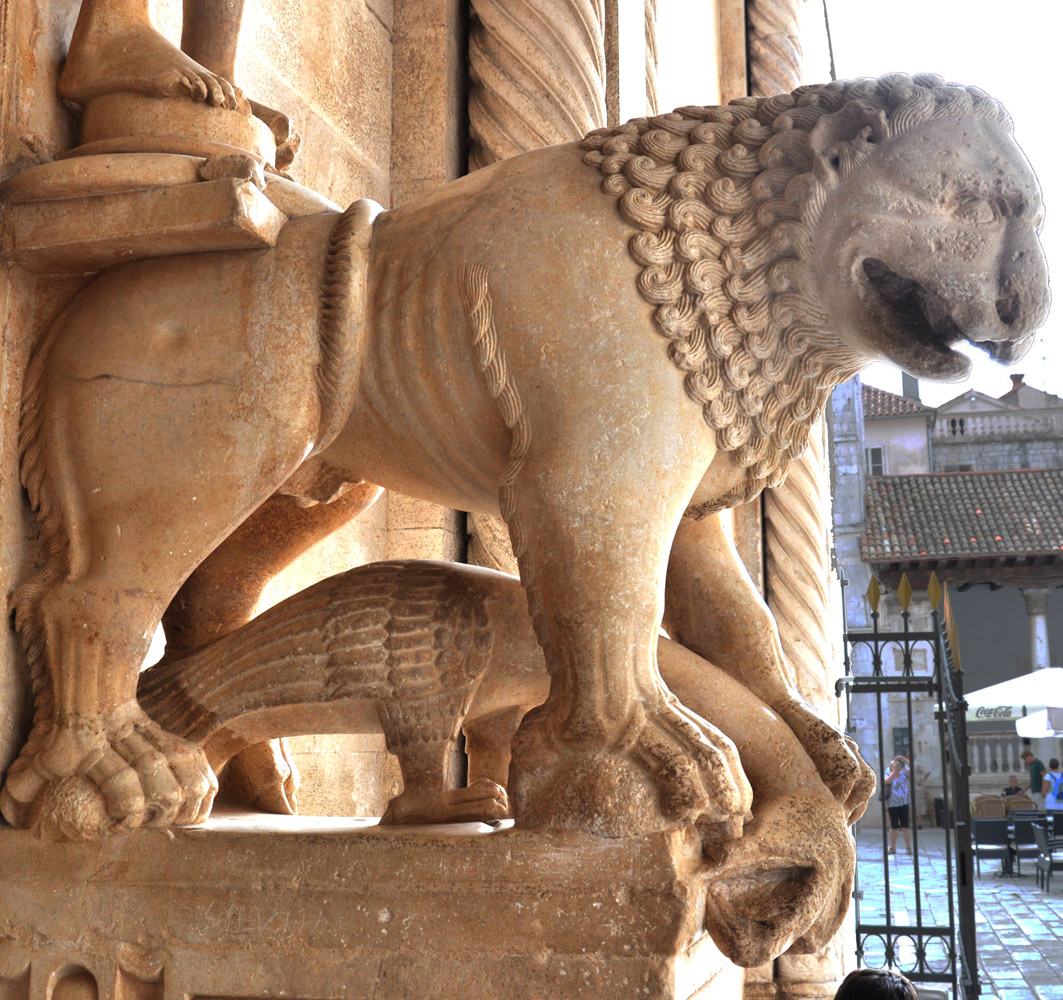
(3)
As for the negative aspects of the figure of the lion, these undoubtedly have less impact than the positive ones, focusing mainly on the danger that the animal represents for humans due to its ferocity; but giving us, nevertheless, an interesting duality:
from a semantic point of view, the lion presents an ambivalent nature, because it can embody opposing positive and negative values. The roots of this double symbolism are present in the authors of Antiquity and the Bible, who claimed, on the one hand, that Christ was “the Lion of Judah” and then compared the lion, on the other hand, to the Antichrist… (4)
Regarding the fierceness of the lion, there are numerous examples in legends, Christian and also from other cultures, but it is not as feared or despised as other animals or other felines.
I therefore consider that within these connotations of the meaning of the lion, the positive ones far prevail over the negative ones and this same thing will happen in Tibia.
Although the lion in Tibia has existed since the beta phase in version 5.1, it was just a mere copy of the real animal without any meaning:
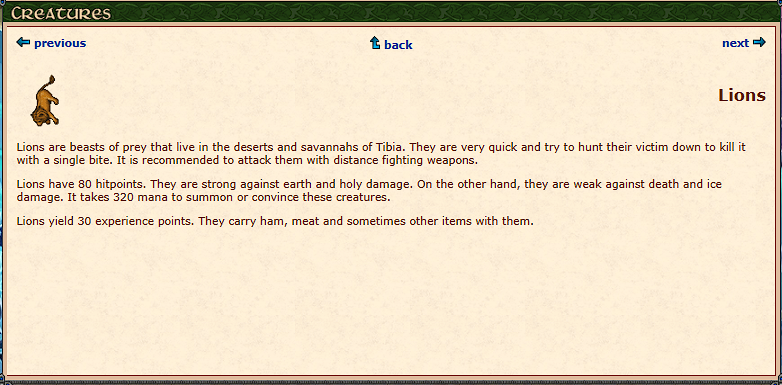
(5)
The lion takes on true in-game meaning and importance within Tibian lore in the 2014 Winter update with the introduction of Lion's Rock.
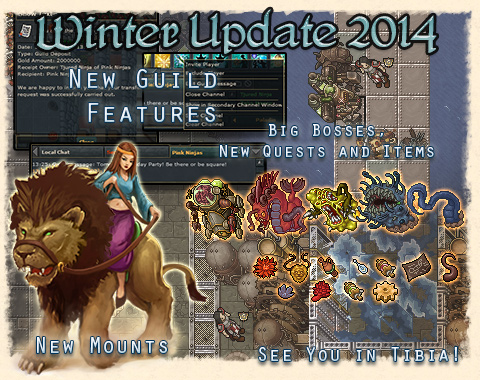
This quest introduces the idea of lions that roam around and protect ancient sacred temples, leaving it to the player's interpretation whether the lions were the guardians of these places or the very object of devotion within them.
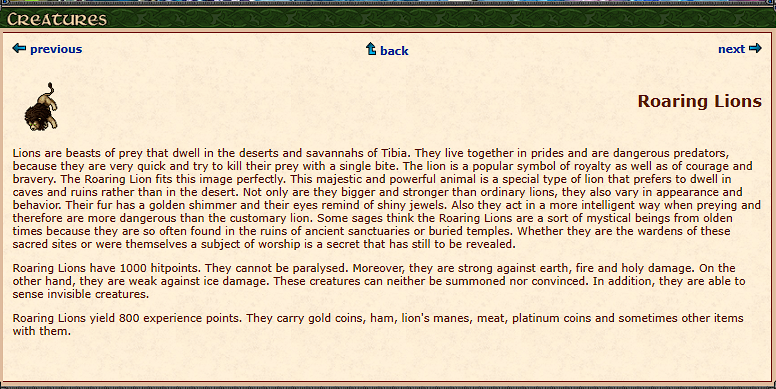
(6)
The Roaring Lions and Noble Lions (these are presented as a superior variant as a pretext for the mount) are thus introduced as mythical animals that possess the positive and negative characteristics of the lion mentioned previously: “The lion is a popular symbol of royalty as well as of courage and bravery”, as well as “Lions are beasts of prey [...] are dangerous predators, because they are very quick and try to kill their prey with a single bite”. This introduces the meaning of the figure of the lion into Tibian lore, and will be taken up later in two more quests.
In the Lion's Rock quest, we are told about the discovery of ancient ruins within a rock formation in Darashia, and upon entering the rock we find three tests to access its inner sanctuary: 1) The lion's strength (where we have to deliver the blood of a cobra). 2) The lion's tears (where we sacrifice holy water). 3) The lion's beauty (where we deliver a Lion's Mane Flower). This gives a very positive meaning to the lion: strength, purity and beauty; and this connotation is reinforced when inside the sanctuary (a magical place that has not passed through in time: “You enter a temple area which is gorgeously decorated and mysteriously unaffected by the course of time”) we find and translate some fragments that tell us about the greatness of the lion and its triumph over other animals that are given very negative characterizations:
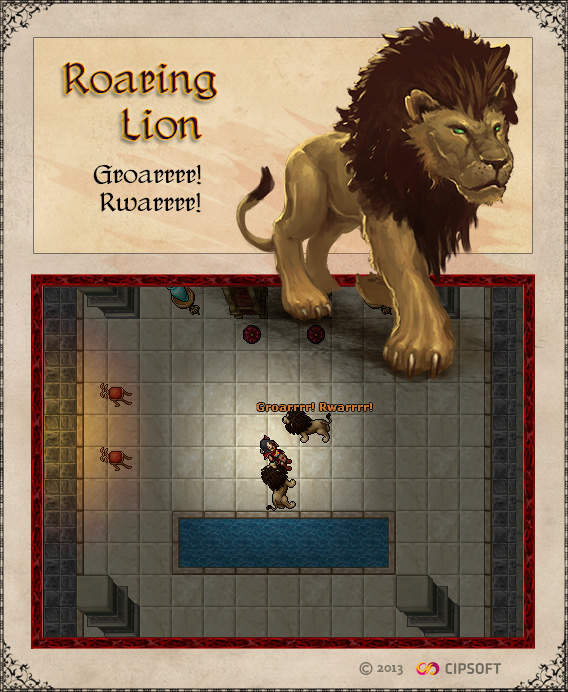
And the mighty lion defeated the greedy hyaena. As a sign of victory he took its blood, red as voracity and lust, and created a precious treasure.
And the mighty lion defeated the lazy lizard. As a sign of victory he took its egg, blue as sloth and conceit, and out of a foul creature he created a precious treasure.
And the mighty lion defeated the jealous snake. As a sign of victory he took its eye, yellow as envy and malevolence, and out of a foul creature he created a precious treasure
And the mighty lion defeated the treacherous scorpion. As a sign of victory he took its poison, violet as deceit and betrayal, and created a precious treasure.
This triumph over four animals (hyaena, lizard, snake, scorpion) is not random but will be taken up later in the game's lore. In the Lion's Rock quest it is clear that the positive qualities of the lion prevail over the negative ones. And this also leaves, in the Tibian thought, the idea of a royal and brave lion who stands out as a caretaker of temples.(7) This triumph of the positive is finalized when, at the end of the quest, the brave and fierce lion becomes tame and bows before a true hero, allowing them to ride him (this characteristic is also a constant motif in art and literature since Antiquity): "Nothing but death awaits you, if you try to break the peace of these majestic creatures without the right to enter their realm. Though, if you can convince them that you have a heart of a lion yourself, they might even bow to you".(8)
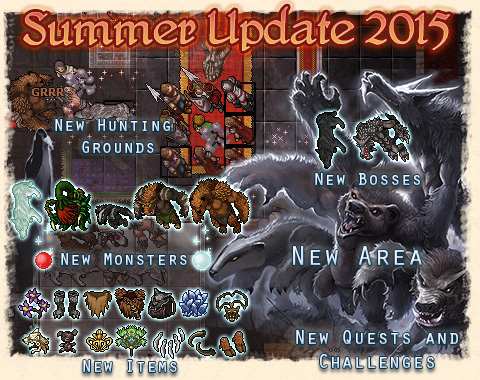
In the following update after the introduction of Lion's Rock, Grimvale and the werebeasts are introduced into the lore: it is a disease or curse in which humanoid creatures (humans, elves, orcs, etc.) lose their reason and adopt bestial characteristics. This condition is transmitted by the bite of these werebeasts and is known as the Curse of the Full Moon, because at the beginning of the disease it is only on the nights of the full moon (the 12th, 13th and 14th of each month in Tibia) when the infected are transformed into these beasts without control of themselves; however, as the condition worsens, these affected people lose total control of themselves and are transformed into werebeasts forever. That is why it is not unusual for many people to fear the curse, and also to hate and reject those infected. This lore continues in subsequent updates in which the curse expands from the island of Grimvale to other areas of Tibia: Edron, Darashia and finally from Ankrahmun to Tiquanda. And although in its beginnings in Grimvale the connotation of the werebeasts in the Tibian imagination was definitely very negative, this ended up changing towards a more dual and positive conception, of course this change occurred with the figure of the lion and was also taken up again in Oskayaat lore.
It is in the 2020 summer update that the story of Lion's Rock finds its continuation with two quests about lions that are intertwined in Tibian lore, let's focus first on the story of the werelions.
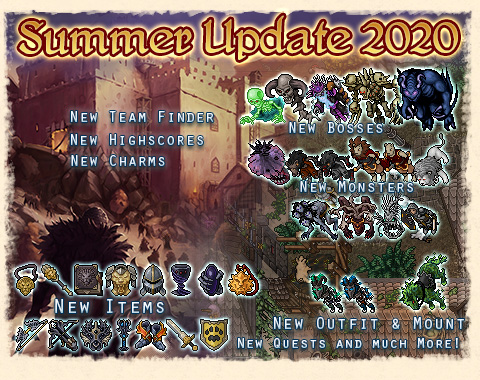
In “An Ancient Feud” the lore of the werebeasts continues when the disease or curse spreads to Darashia; and it acquires perhaps its most negative representation with the attempted alliance of the werehyaenas with the undead (it is known that these represent the negative in the beginnings of Tibian lore). However, werelions and werelionesses are also introduced.
The main characteristic of werelions understood as werebeasts is precisely what differentiates them from these: and it is that werelions have learned to control the “curse” or disease; werelions do not lose reason or self-control, and can consciously transform into their human form or their werebeast form (the NPC Domizian is precisely a werelion in his human form). For them it is not a curse but a “gift” that gives them strength and powers, so they even transfer the “gift” to those they consider worthy.
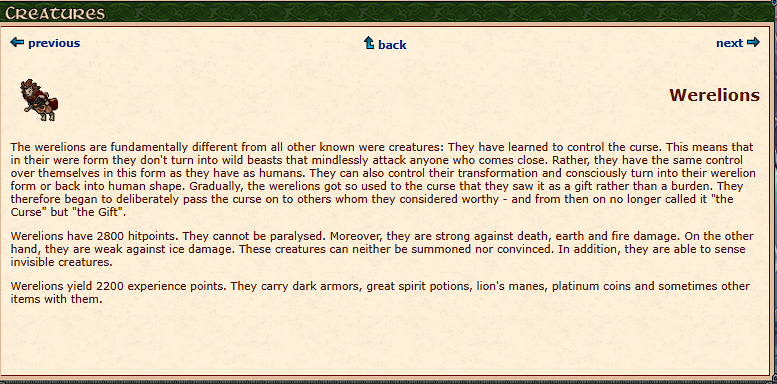
(9)
It is clear from their civilized social structure with a king (Heliodor), and from the sanctuary in which they live that werelions are very different from other wild werebeasts that roam caves. And it is also within its sanctum that we find another trial that refers directly to the Lion's Rock quest. To be worthy of being in Heliodor's presence, players must defeat four bosses, drop four items representative of them, and use them on a feline statue:

Of course this is a reference to the Mighty Lion who defeated the greedy hyaena, the lazy lizard, the jealous snake and the treacherous scorpion to obtain: blood, an egg, an eye and poison, to create a precious treasure with them.
We can infer from this that the original werelions - before being infected - (as well as now us players) completed the Lion's Rock quest, defeated these mini bosses and thus acquired the positive qualities and values of the lion for themselves. It is not strange, then, that after these trials and purifications that we went through from Lion's Rock to An Ancient Feud, the werelions have become a werebeast with a rather positive characterization.
This triumph of the positive over the negative ends up being consolidated in the werelions through the ritual to bless the fire that they possess, that is, the Holy, also the source of their main attack. It is also with this ritual of the werelions that in the quest the player breaks the alliance that the werehyaenas were making with the undeads: the most positive icon of the werebeasts - the lions - thus strikes down the most negative one - the hyaenas, allying themselves with Drefia.

In Tibia the Holy is not fire, but blessed fire or a divine attack. I like to understand the Holy how it is explained in the origin of the Paladin Familiar: as a gift from the gods to humanity to fight evil, which is formed by the combined essence of the suns Fafnar and Suon into a vessel the gods had formed from a part of the fallen Tibia's hear (the sun in our world is not just a mere ball of fire but thousands of other things, and likewise Fafnar and Suon are not only fire).(10) Of course this gift was not given to all Tibian vocations but only to the blessed paladins. In Tibian lore, the two vocations that enjoy an extra blessing are the knights for descending from the demigod Banor and the paladins for descending from his beloved daughter, Elane.
Likewise, the Holy attack is not very common in creatures and the list of those that have it does not seem to me to belong entirely to creatures with negative connotations, although this is debatable.
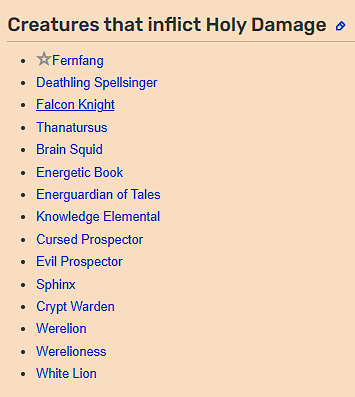
(11)
(On the other hand, the list of creatures weak to holy does include some pretty disgusting monsters among its ranks: Holy Damage/Weak | TibiaWiki | Fandom).
It is in this way that the werelions once again are representatives of duality: beasts and humans, but also of how good triumphs over evil in Tibia through purification: they overcame the curse by transforming it into a gift and also obtaining the Holy like a second gift. The phrase you need to enter his sanctuary also represents their bivalent spirit: “The sun guides our hearts. The moon guards our dreams”. This dual nature of werebeasts overcoming the curse of the full moon to accept it as part of themselves will be explored later in Oskayaat lore.
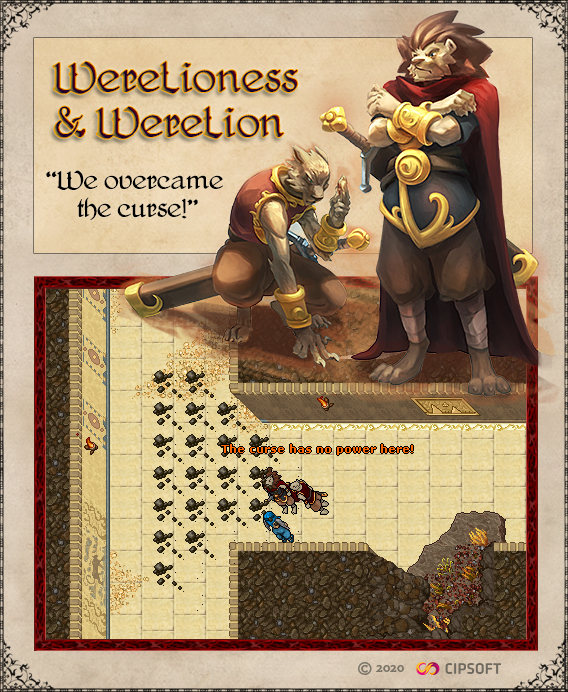
This article about the lion in tibia cannot conclude without taking into account the order of chivalry that chose it as its representative animal: led by Kesar Etzel, the Order of the Lion.
The Order of the Lion Quest is introduced, in fact, in the same update as the werelions: summer 2020. The story of Kesar is part of the most recent lore of the game, specifically it concludes the story of the three Knightly Successor Orders of Tibia; where an order of knights in the service of King Xenom, father of our King Tibianus III, is separated into three factions when the three Etzel siblings - Oberon, Kesar and Scarlet - begin to have differences in their way of seeing the world and the future of the order, thus each one taking different paths.
Oberon was the first to form his own order, he chose the falcon as his pet and isolated himself in his fortress of Edron, then disappeared overnight without a trace. Of Kesar, the official story is that he settled in Darashia, he chose the lion as the model of virtues for his order and made various pilgrimages to Lion's Rock and then also disappeared. While Scarlet is known to have formed or joined a low-profile covert operation in Ankrahmun with the cobra as a symbol. That is the official story reported about the three siblings in the books and documents of Tibia. (12)
However, in The Order of the Lion Quest, we players know that the lions left Darashia for Bounac for unexplained reasons. And I find it very interesting to note that although in Tibia there are no books or texts that explain in writing how the lions arrived at Bounac, in the teaser we are told that this is rather a story that is told in oral tradition: in songs and legends by word of mouth.
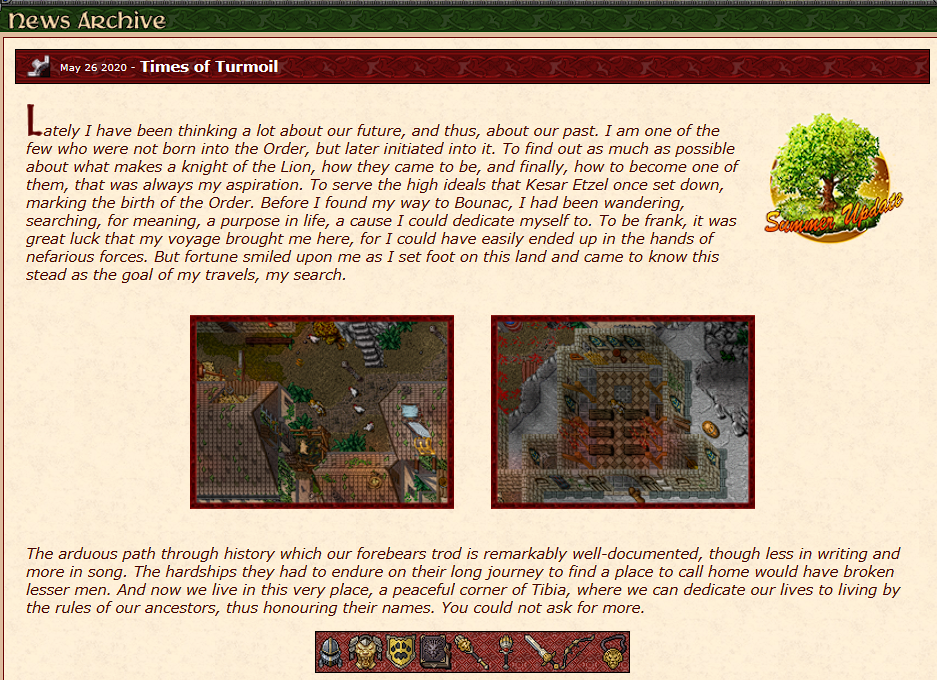
(13)
In professional studies of narratives it is important to distinguish between “literature” and “orature”; the latter refers to the oral tradition of telling stories in legends or songs, and is distinguished from literature because it is not “the same thing but out loud” but rather has its own characteristics. Epic stories of heroes have always had an important place in orature and it is quite significant that this also happens in Tibia.
We know then that, after separating from the order of King Xenon, Kesar took his order to Darashia where they made pilgrimages to Lion's Rock: “It is rumored that Kesar believed the mythical lions to hold the key to true chivalric virtue”,(14) so we can assume that the order also carried out the trials of the Lion's Rock quest, thus acquiring the positive values of the lion. However, these pilgrimages stopped and Kesar and his knights left Darashia, for what reason? Well, very possibly due to the threat of the Curse of the Full Moon.
Unlike Oberon who was determined to explore lands beyond the known and unmask evil at its roots; and Scarlet who had her own agenda and interests alongside Galthen; Kesar did not want to go further, he did not want to discover, nor investigate, he was not seduced by knowledge or strength, Kesar Etzel only wanted to protect and treasure the world that he had always known from the forces of evil.
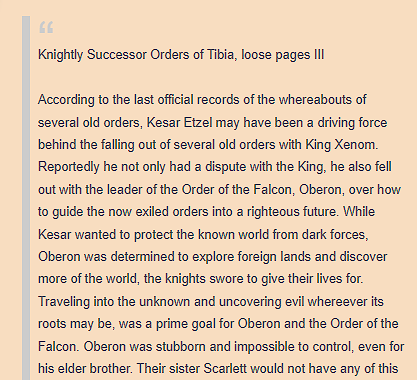
We can speculate that Kesar and his knights left, continued their own epic away from the Curse of the Full Moon and eventually settled in Bounac, from where the order of lions will protect the known world from evil. Eventually, Kesar died, but the order continues its course, led by his direct descendant Kesar the Younger. And we can also speculate that they left behind those knights of the order who were infected by the Full Moon Disease, and that these are the werelions. The bravery of the order of lions was such that its infected members sacrificed themselves, staying behind so as not to continue infecting, but not having a bad end, quite the opposite.
And, under this narrative, it is not strange that the werelions overcame the curse: they were not simple humans but knights of the king in the service of Kesar, they had made a pilgrimage to Lion's Rock, they had gone through the tests to obtain the positive values of the lion and they had kept them even when infected, that was why they had beaten the disease, that was why they managed to overcome the curse and turned it into their own gift, into their own powers. Here we can highlight a duality of the order of the lions over the other orders: they have been the only ones to separate into two groups, those who stay behind in Darashia as werecreatures and those who continue forward towards Bounac as pure human beings.
And, in fact, Kesar himself could have also acquired the gift, he and the other knights could certainly have been infected and have acquired the powers and both positive and negative qualities of the werelions. But they didn't.
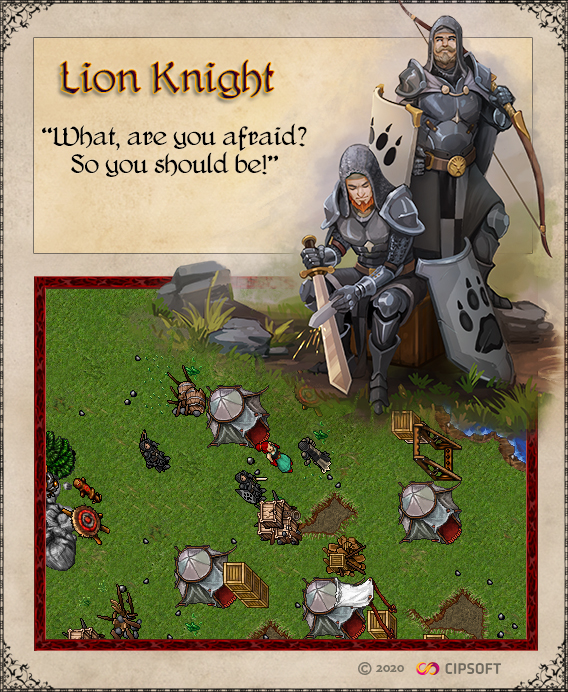
And with this Kesar broke with Scarlet and with Oberon: Scarlet and Oberon gave in to their contaminated and corrupted environments; both lost themselves and their chivalric ideals, they became monsters like those they previously fought against; but they gained strength and immortality in exchange, and the same for their subjects. But not Kesar. Kesar had his own chance but, out of fear or anger, he rejected it. Kesar died as a knight and preserved his ideals. The lions of Bounac do not attack you (with the exception of the Ancient Lion) unlike falcons and cobras. Oberon lost to Zao's corruption through the Spatial Warp Almanach; Scarlet was corrupted when she was given the Cobra Amulet; but Kesar—although he was in danger first from the werebeasts, and then came close to the curse of Yselda and the Megasylvan Sapling—was not defiled. With Kesar, despite all the obstacles, good triumphed over evil, and even in the current time arc, good won again when the players - with the help of Kesar the younger - defeated Drume, Fuge and their usurpers sent by the falcons in an attempt to bring corruption to Bounac. Kesar did not end up being a boss that we fought, but rather his descendant helps us in the battle against an enemy so lacking in personality that he drops lion set.
It is not strange, following this line of thought, that the story of Kesar and the order of lions is presented in its own quest, which even gives us a title within the game “Hero of Bounac”. While Scarlet and Oberon's stories are presented as substories within quests surrounded by danger and evil: Grave Danger and The Secret Library. With the order of the lions, Tibia was able to defeat evil.
Throughout this article we saw how the lion in tibia is represented as a dual figure: it represents positive values of courage, bravery, protection and royal pride; but it also has a negative meaning as it is a dangerous beast. However, in this symbology and in the lore of Tibia, the positive triumphs over the negative in the lion, and the lion is incarnated as a true hero of good who manages to defeat evil despite all the difficulties. In Lion's Rock, in the werelions and in the Order of the Lion, a perfectly intertwined structure of a narrative planned for years is presented: which begins in 2014 and is resumed in 2020, but which is not yet concluded. The history of Bounac, the lore of the werebeasts, The Knightly Successor Orders of Tibia, as well as the mystery of the Prime Artifacts still have a current continuity within the game and represent not only the current and modern lore of Tibia but also the future towards where the game's story is headed.
There are many mysteries left in the history of Grimvale;(16) The adventurers of Galthen is going to continue; the presence of the Ancient Lion Knight and the unreachable Ancient Lion Archer and Ancient Lion Warlock are unclear; the secret of the Prime Artifacts is still very interesting; and even one of the undiscovered secret achievements is found within the summer 2020 update in which werelions, Bounac and Soulwar were introduced.
I look forward, with enthusiasm, to seeing what further development is going to be given to the figure of the lion within the lore of Tibia, as well as to see what animals with good or evil meanings are going to be introduced into the game in the future.
-Anne
Index:
(1) There is a “link with the divine resurrection of Christ, due to the legendary belief that lions were born dead and came back to life three days later thanks to the insufflation of their father's breath”. Jorge Martinez Montero, “La imagen del león al servicio de la representación del poder en las escaleras del Renacimiento español”, in Emblemata, 19, 2013, p. 375-392, p. 376.
(2) Francisco de Asis García García, “León” en Base de datos digital de Iconografía Medieval, Universidad Complutense de Madrid. Online:https://www.ucm.es/bdiconografiamedieval/el-leon.
(3) The Columns at the Entrance to St. Lawrence Cathedral.
(4) Francisco de Asis García García, “León” en Base de datos digital de Iconografía Medieval, Universidad Complutense de Madrid. Online:https://www.ucm.es/bdiconografiamedieval/el-leon.
(5) “Lion”, en Tibia - Free Multiplayer Online Role Playing Game - Library
(6) “Roaring Lion” en Tibia - Free Multiplayer Online Role Playing Game - Library.
(7) Let us remember that also in real life: “In the specific case of his connection with the Emblematic, his vigilant presence as guardian of sacred spaces on the threshold of churches is notable”. In Jorge Martinez Montero, “La imagen del león al servicio de la representación del poder en las escaleras del Renacimiento español”, in Emblemata, 19, 2013, p. 375-392, p. 380..
(8) Teaser del Winter Update 2014: Tibia - Free Multiplayer Online Role Playing Game - News
(9) “Werelion” en Tibia - Free Multiplayer Online Role Playing Game - Library.
(10) “Summon Paladin Familiar” en Tibia - Free Multiplayer Online Role Playing Game - Library.
(11) En: Holy Damage/Weak | TibiaWiki | Fandom.
(12) Mainly in Knightly Successor Orders of Tibia I, II, III. Knightly Successor Orders of Tibia I (Book) | TibiaWiki | Fandom
(13) “Times of Turmoil” in Tibia - Free Multiplayer Online Role Playing Game - News
(14) En Knightly Successor Orders of Tibia II, Knightly Successor Orders of Tibia II (Book) | TibiaWiki | Fandom.
(15) En Knightly Successor Orders of Tibia III,Knightly Successor Orders of Tibia III (Book) | TibiaWiki | Fandom.
(16) Grimvale Quest | TibiaWiki | Fandom
| Name | TC Amount |
|---|---|
| Sabin Rene | 1000TC |
| Cavaleiro Kyon Efusa | 600TC |
| Anonymous | 550TC |
| Hegal | 500TC |
| Pala Thebs | 250TC |
| Acolyte Rain | 250TC |
| Vall Astaoldana | 150TC |
| Parrilla | 100TC |
I love how articles uncover more content in Tibia and help me understand Tibian universe better.